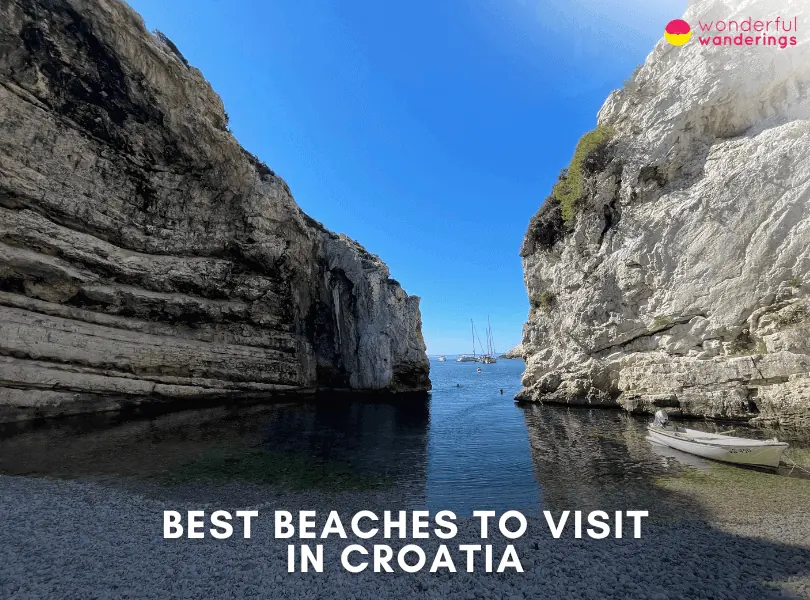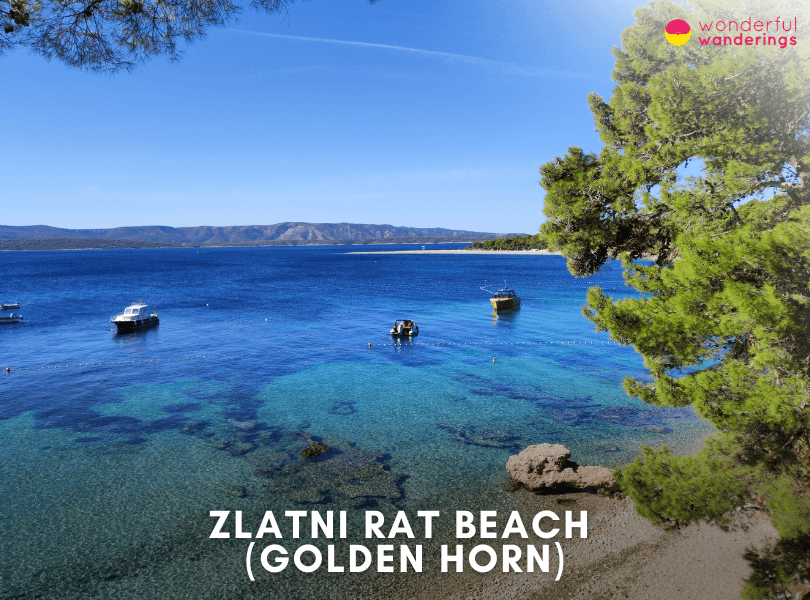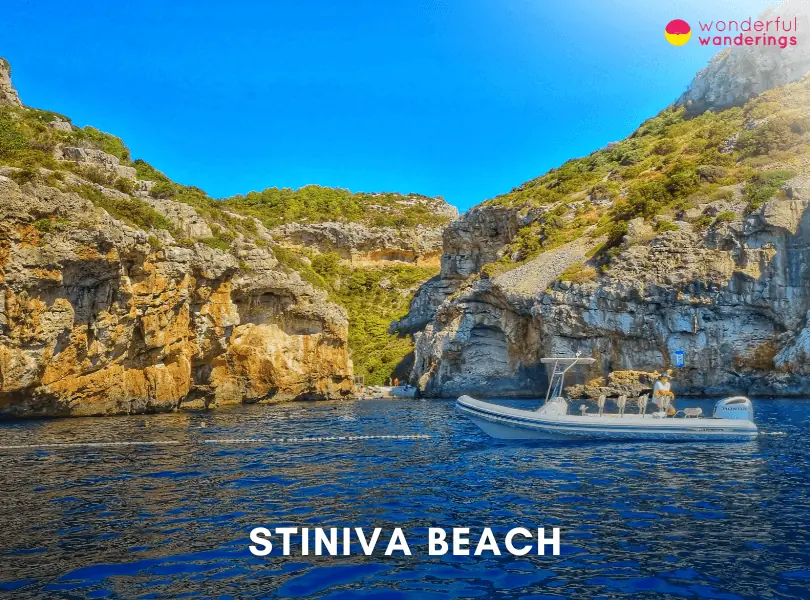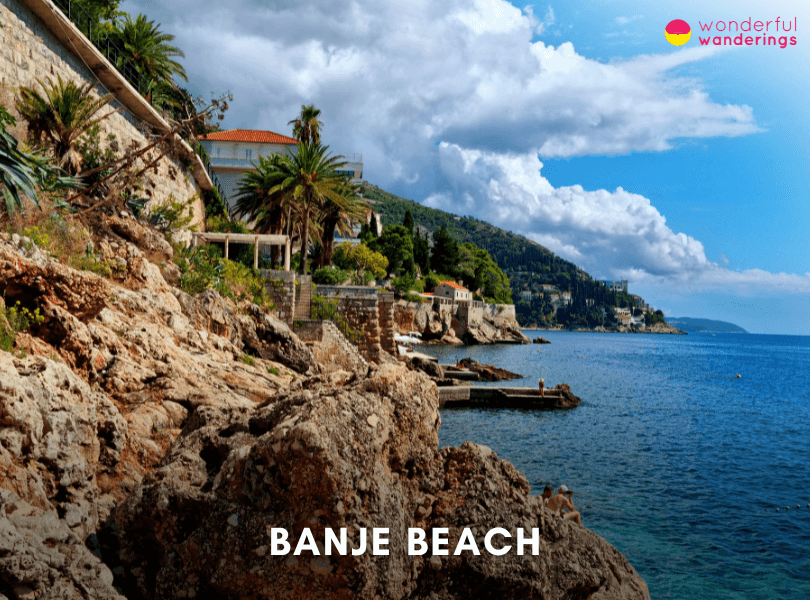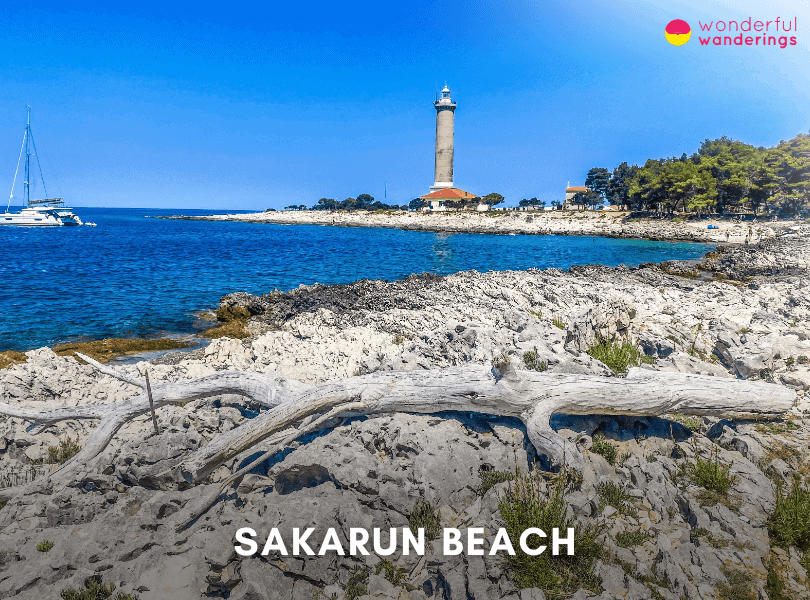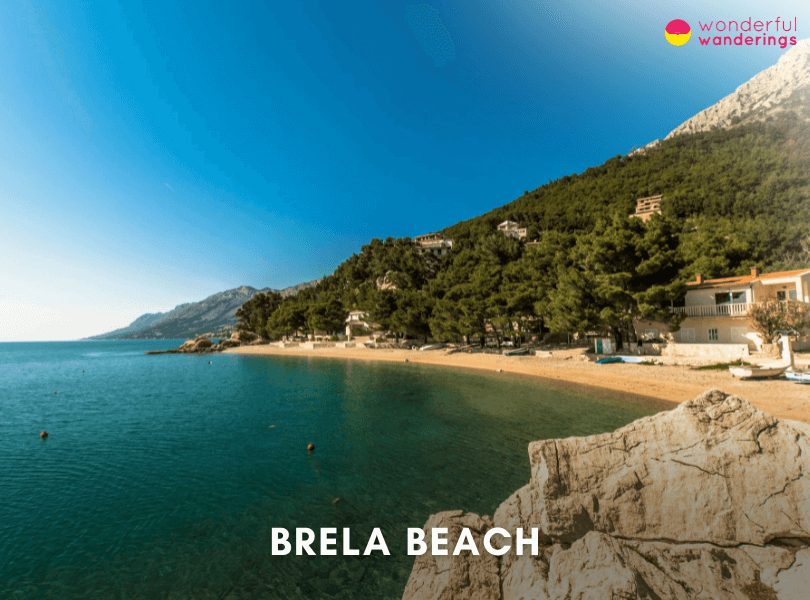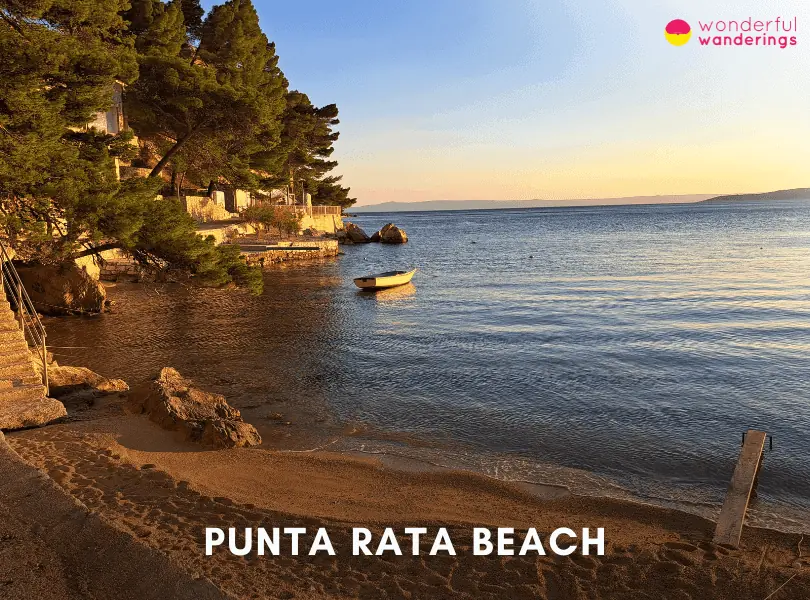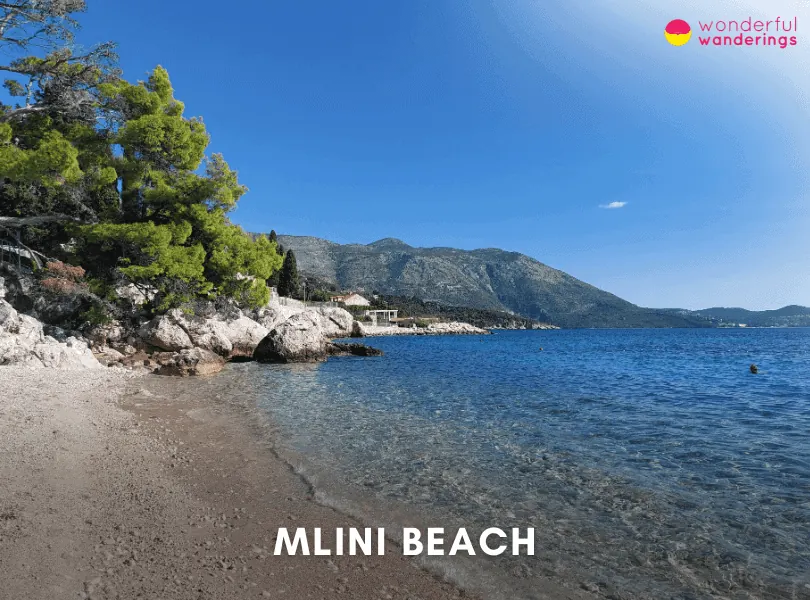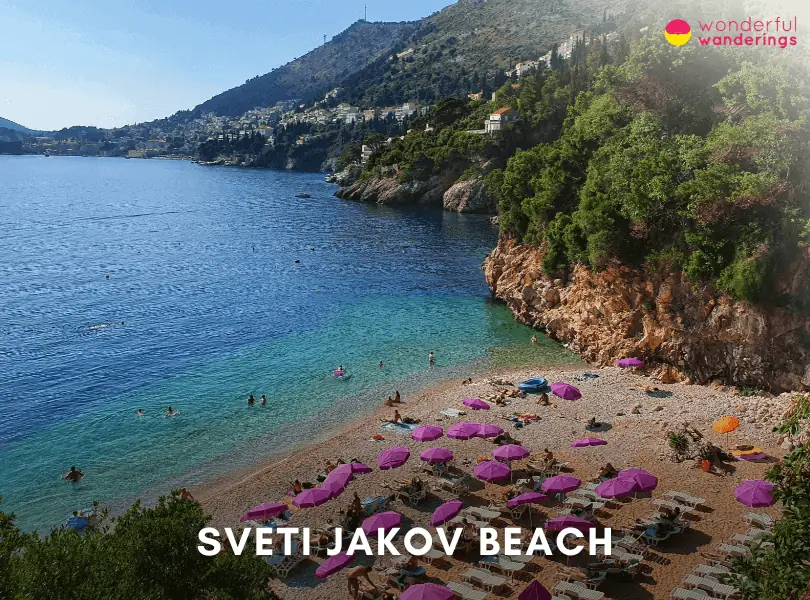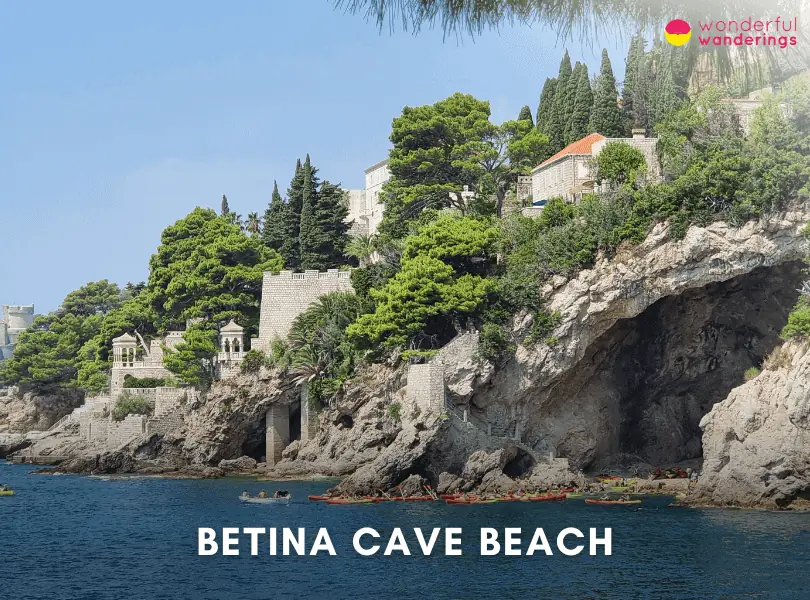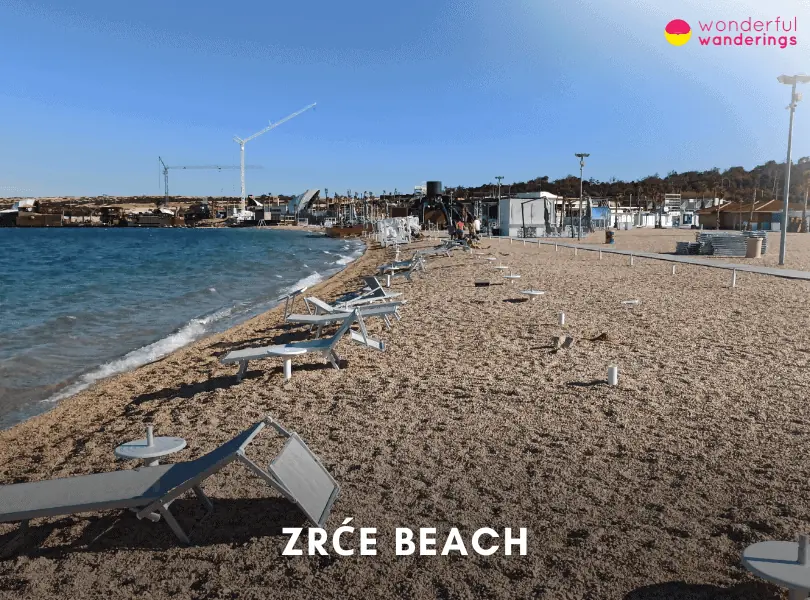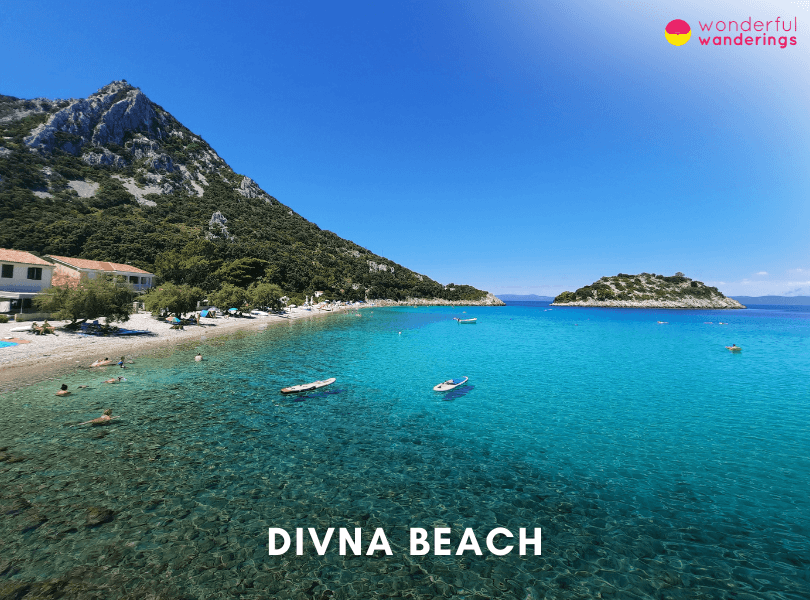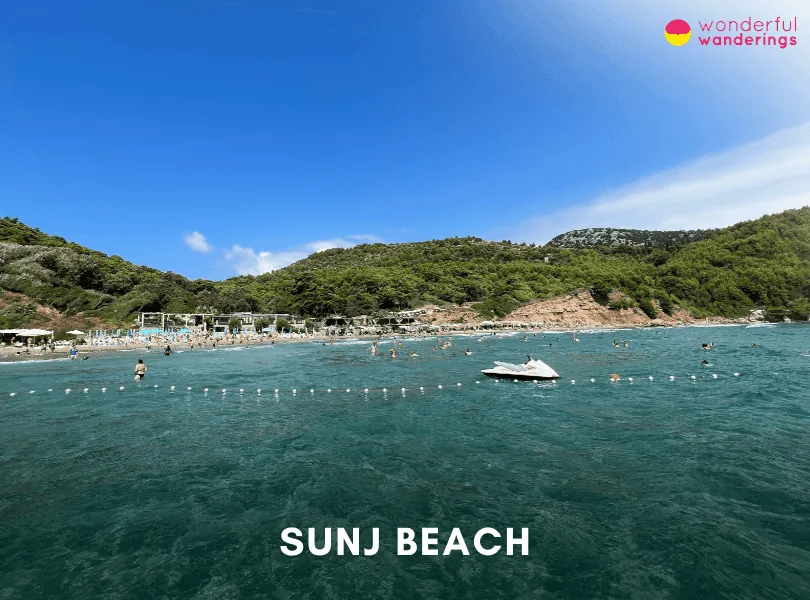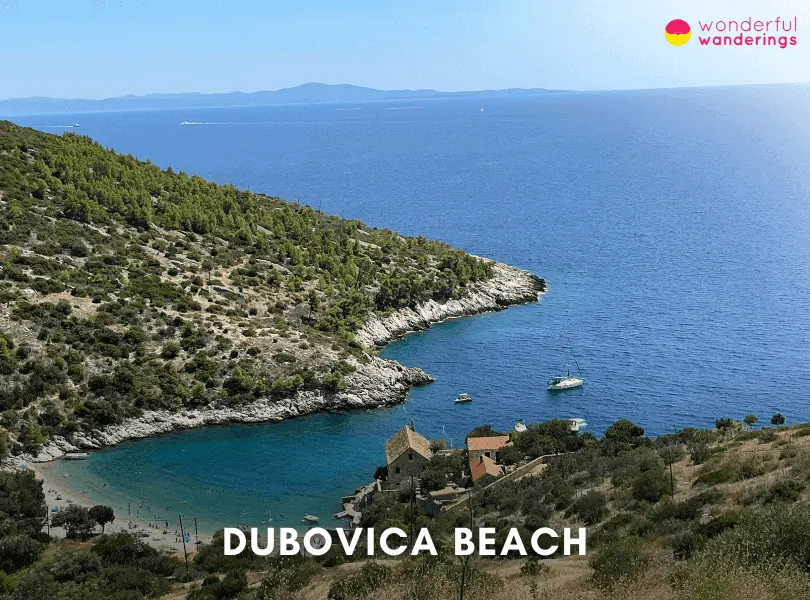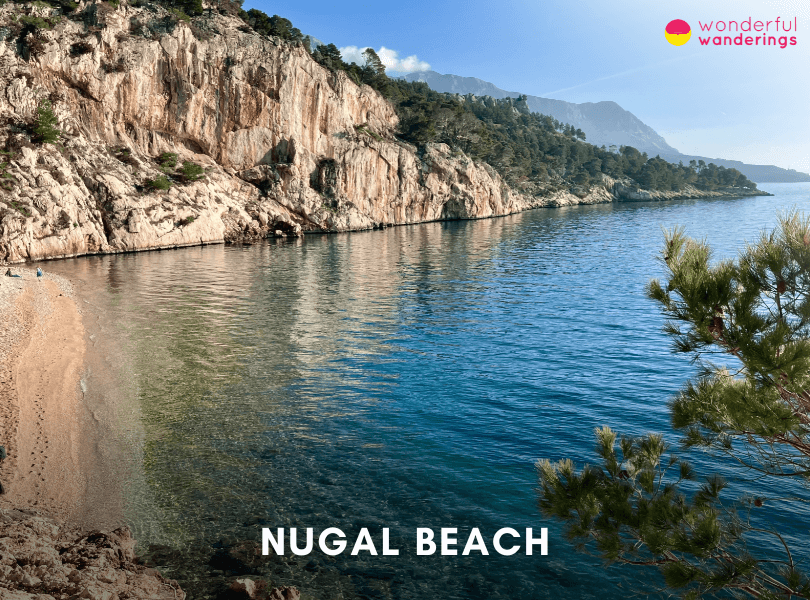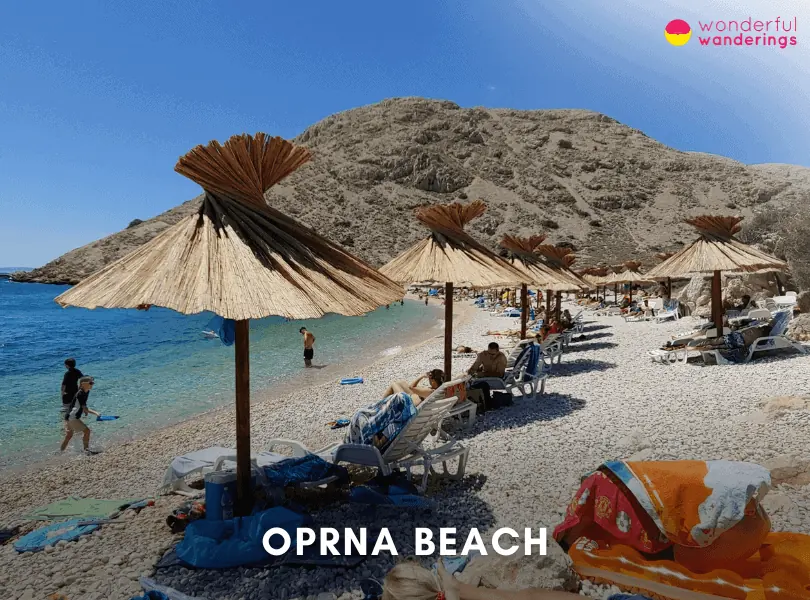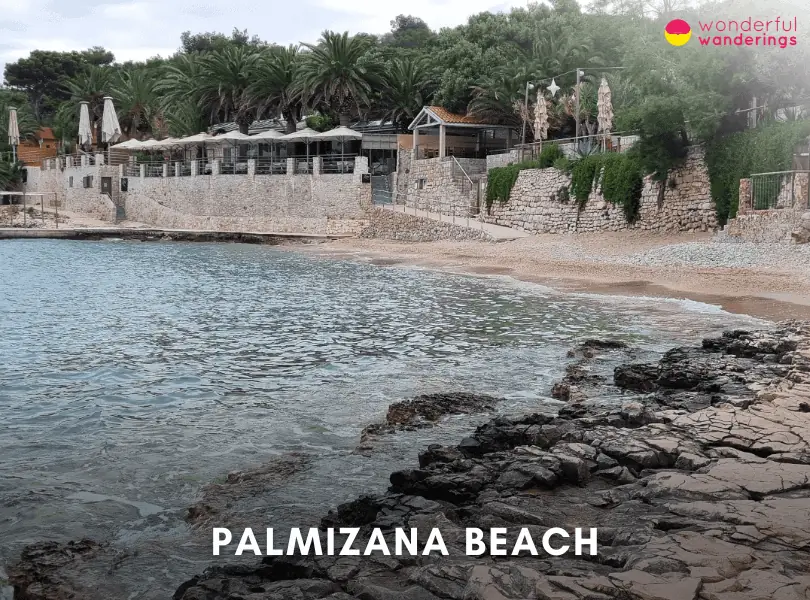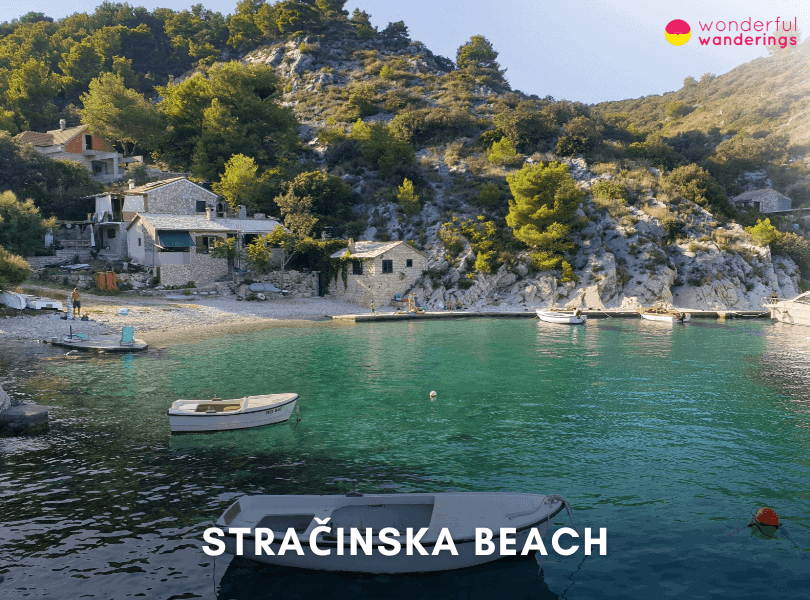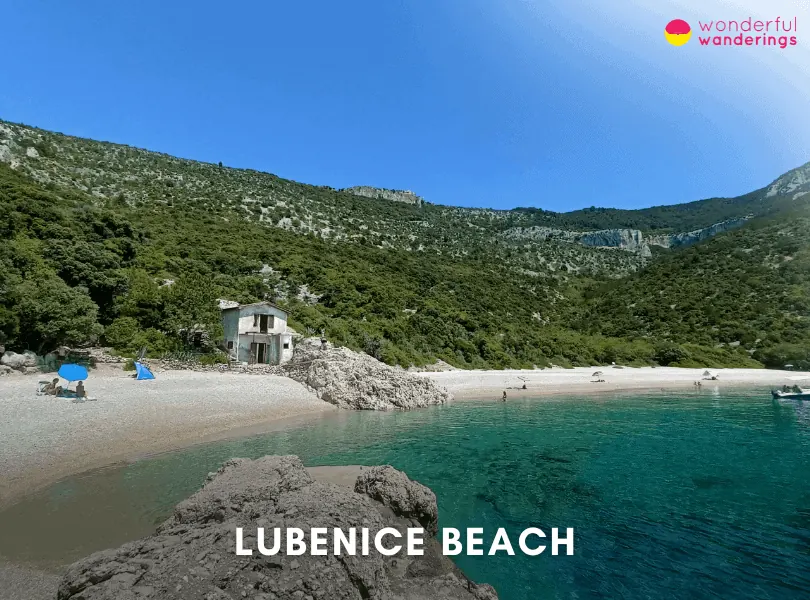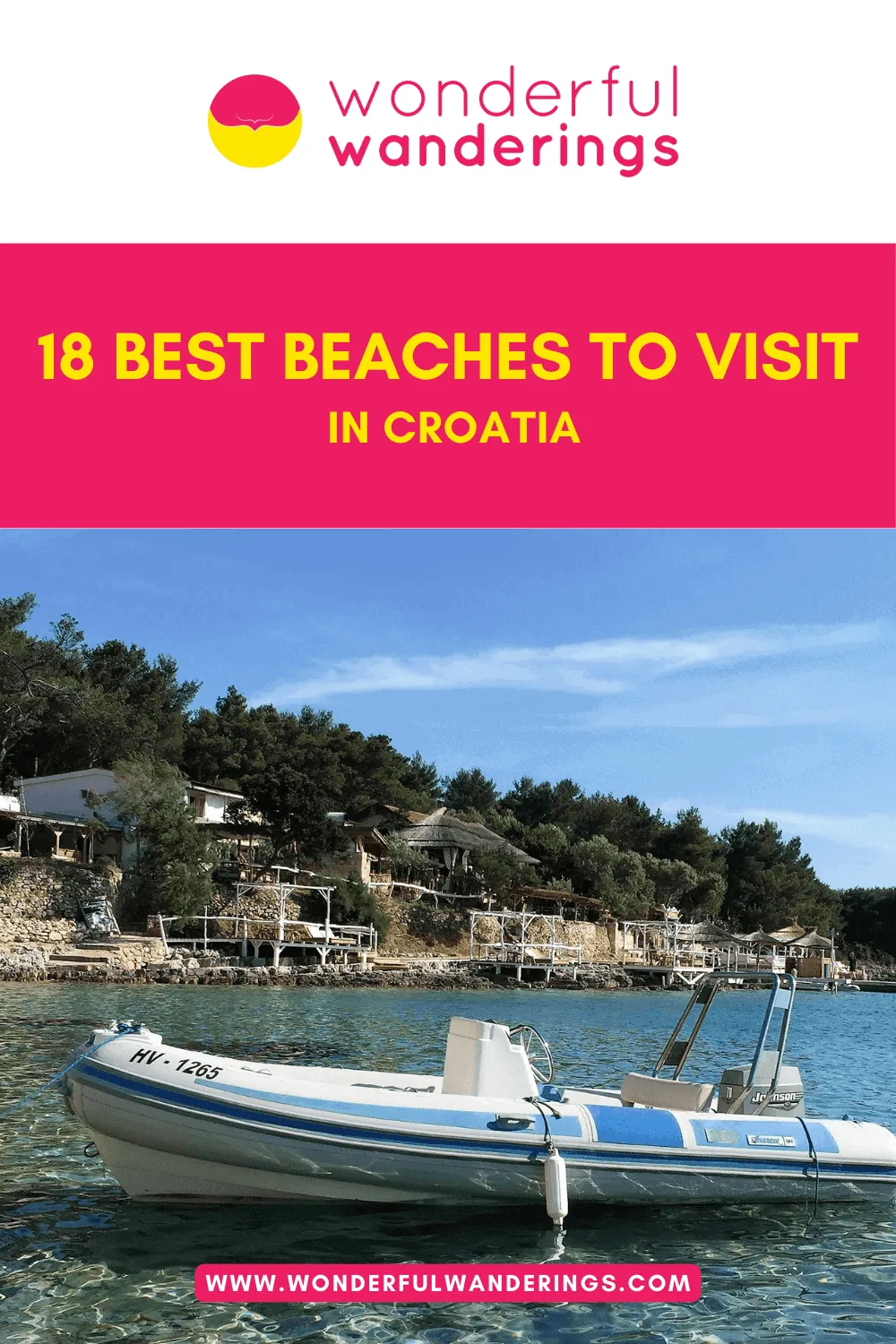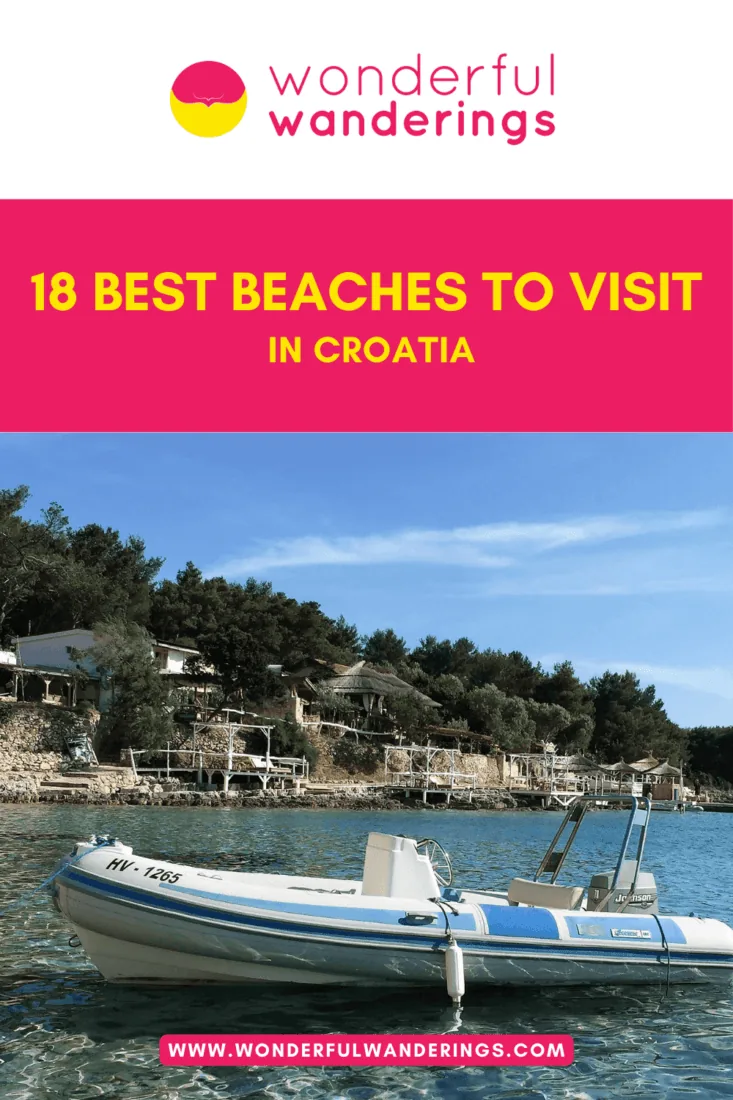Croatia features beaches along its Adriatic Sea coastline and islands, ranging from isolated pebble coves to sandy beaches. Zlatni Rat Beach on the island of Brač features golden pebbles and an iconic horn shape-shifting with winds and currents. Its smooth pebbles, beachfront cafés, water sports rentals and natural beauty attract tourists and locals. Sakarun Beach on Dugi Otok island earns the name “Croatian Caribbean” with its 800 meters (0.49 miles) white sand bay and calm waters surrounded by pine forests. Banje Beach uniquely blends Croatian culture and the history of Dubrovnik with an active party scene focused around the Banje Beach Club, which hosts events and concerts. Zrće Beach on Pag Island is called the “Croatian Ibiza” for its summer beach clubs like Papaya and Aquarius, hosting famous DJs and nonstop parties day and night centered around dancing and water sports. Nin Beach, also called Queen’s Beach, spans over 3 kilometers (1.8 miles) with warm shallow waters and sandy sea floors perfect for families, with amenities, shops and restaurants in the nearby historic town of Nin.
Listed below are the best beaches to visit in Croatia.
- Zlatni Rat Beach. Zlatni Rat Beach, often called the Golden Horn or Golden Cape, is a 0.5 kilometers (0.3 miles) pebble beach on the Croatian island of Brač, known for its golden pebbles and ever-changing shape that shifts from side to side with the winds and sea currents. It offers smooth pebbles ideal for swimming, water sports rentals, beachfront cafés and restaurants and amenities like loungers, showers and lifeguards.
- Stiniva Beach. Stiniva Beach is a secluded pebble beach surrounded by towering limestone cliffs on the Croatian island of Vis. It lies in a narrow bay with turquoise waters and smooth round pebbles. Facilities include a beach bar, food service, outdoor shower and restrooms. Its challenging access and terrain make it unsuitable for wheelchairs and those with limited mobility. Activities include swimming, snorkeling, paddleboarding and appreciating the natural scenery.
- Banje Beach. Banje Beach is Dubrovnik’s main city beach, spanning 300 meters (0.18 miles) along the sea below pine trees. Its clear blue waters, fine pebbles, water activities, volleyball courts, amenities and seaside dining make it popular but crowded, especially when cruise ships visit. It has mostly wheelchair-accessible concrete access ramps and paths. Attractions like the Old Town walls and cable car are within walking distance.
- Sakarun Beach. Sakarun Beach is a 0.8 kilometers (0.4 miles) bay on Dugi Otok island with fine white sand and calm, waveless waters. Pine forests surround the beach, featuring white pebbles, seagrass meadows, two seasonal beach bars, showers and lifeguards. Accommodations are in nearby villages since camping on the beach is prohibited. Activities include swimming, snorkeling and appreciating the remote island scenery.
- Brela Beach. Brela Beach stretches 6 kilometers (3 miles) along the Makarska Riviera, known for its pebble coves framed by pine forests. The most famous cove features the iconic Brela Stone outcrop. It has smooth pebbles, calm waters ideal for families, amenities, seaside restaurants and water sports rentals. Its terrain is challenging for wheelchairs. Attractions include ancient fortresses, villages and boat trips to islands.
1. Zlatni Rat Beach (Golden Horn)
Zlatni Rat Beach, often referred to as the Golden Horn or Golden Cape, is on the southern coast of the Croatian island of Brač, about 2 kilometers west of the harbor town of Bol. This pebble beach stretches 0.5 kilometers (0.3 miles) into the Adriatic Sea and is surrounded by pine trees and steep rocky cliffs. The beach is most famous for its ever-changing shape. Depending on the winds and sea currents, the tip of the horn shifts from side to side, sometimes curling nearly back to form a lagoon. This distinctive shape and golden pebbles make Zlatni Rat one of Croatia’s most iconic beaches.
The pebbles of Zlatni Rat Beach are smooth, which is ideal for swimming. The beach also offers a variety of water sports like windsurfing, kitesurfing, jet skiing and kayaking for rent. Powerful afternoon winds create excellent conditions for wind-powered sports. Visitors can rent sun loungers and umbrellas at Zlatni Rat. There are also beachfront cafés and restaurants right on the horn. Basic amenities like public restrooms, outdoor showers, changing facilities and lifeguards are available during the summer. The area gets very crowded, especially when tourist boats arrive mid-morning. Bol offers a lively nightlife scene. The best time to experience Zlatni Rat’s beauty is early morning before the crowds arrive.
The Zlatni Rat Beach is unsuitable for wheelchair users or those with limited mobility due to the steep access paths. Well-behaved leashed dogs are allowed. Nearby attractions include Roman-era archaeological sites, boat trips to secluded coves and the Blue Cave and the harbor promenade of Bol. Zlatni Rat Beach can be reached by walking, cycling or taking the small tourist train from Bol. Public ferries and buses run regularly to Bol from the mainland and nearby islands. Paid parking is along the road above Zlatni Rat and the neighboring nudist beach. Accommodations range from campgrounds to luxury villas clustered around Bol.
2. Stiniva Beach
Stiniva Beach is on the southern side of the Croatian island of Vis, the farthest inhabited island off the Dalmatian coast. This secluded pebble beach lies in a deep, narrow bay flanked by towering limestone cliffs. Stiniva’s unique landscape and turquoise waters have earned it recognition as one of the most beautiful beaches in Europe.
The pebbles at Stiniva Beach are smooth, round, white and gray stones that extend right into the sea. The beach is relatively small, framed by high cliffs on either side, providing shade during the afternoon. Swimming conditions are ideal, with still waters allowing visitors to see the seabed. Visitors can rent sun loungers and umbrellas at the beach bar on-site and order food and drinks throughout the day. Lifeguards are not permanently stationed at Stiniva. The beach is considered safe for swimming when conditions allow. Basic facilities include an outdoor shower and public restrooms beside the beach bar. More restaurants, bars, shops and hotels can be found nearby Vis, Komiža and Rukavac.
Access to Stiniva Beach requires a short hike on foot down a steep, uneven cliffside trail from the village of Žužeća or by boat, which must anchor just offshore. The challenging terrain makes Stiniva unsuitable for wheelchair users or those with limited mobility. Well-behaved leashed dogs are allowed. The protected cove provides excellent swimming, snorkeling, paddle boarding and kayaking conditions. Stiniva attracts mostly couples and families rather than groups or parties. The beach can get quite crowded in July and August, especially when tour boats arrive mid-morning. Early risers can catch sunrise over the bay for a more peaceful experience.
Accommodation options in villages around Stiniva Beach include campgrounds, apartments, family-run hotels and luxury villas with Adriatic Sea views. Nearby attractions range from Roman-era archaeological sites, scenic cycling routes through vineyards and olive groves, boat trips to the Blue Cave and the cultural hub of Vis Town, where visitors can soak up some Mediterranean atmosphere.
3. Banje Beach
Banje Beach is in the coastal town of Dubrovnik, Croatia, on the Adriatic Sea. Banje Beach stretches 300 meters (0.18 miles) along the sea below the pine trees. The nearest major city is Dubrovnik itself. Its clear blue waters and fine pebbles make Banje Beach a popular swimming spot where visitors can soak up the sun on rented loungers and enjoy seaside dining. Banje is Dubrovnik’s largest beach and can get crowded, especially when cruise ships dock.
Banje Beach is ideal for swimming. There are no strong waves or risky currents. The beach offers fun water activities like stand-up paddleboarding, kayaking and pedal boating rentals. Visitors can play beach volleyball or soccer on designated courts. Banje Beach has all the essential amenities like public restrooms, outdoor showers, changing rooms and lockers for rent. Several beach bars and restaurants are on the shores, known for serving cold drinks, ice cream, pizza, seafood and Mediterranean cuisine. Loungers and umbrellas are also available to rent for €9 ($10, £7) and above.
Banje Beach has a long, paved promenade lined with pine trees that provide some natural shade. Concrete access paths and ramps lead to the beach, making it mostly wheelchair accessible. Leashed dogs are allowed in certain sections. Since Banje Beach is close to the historic Old Town, it attracts everyone from backpackers to families to cruise ship passengers. It tends to be busiest in July and August. To avoid crowds, go early in the morning before 10 am or in the late afternoon. There is no public parking lot, but private parking garages are nearby, charging €18 ($20, £15) and above. The #1 hotel directly on Banje Beach is the high-end Importanne Resort, which has rooms with sea views. More budget hotels and rental apartments are just steps away from the beach. Banje Beach is also within walking distance from Dubrovnik’s luxury hotels, shops, restaurants and attractions like the City Walls and cable car.
4. Sakarun Beach
Sakarun Beach is on the northwest coast of Dugi Otok island in Croatia, about a 90-minute ferry ride from Zadar. This 0.8 kilometers (0.4 miles) bay features fine white sand and clear waters, earning it the nickname “Croatian Caribbean”. The beach is surrounded by fragrant pine forests that provide welcomed shade on hot summer days. Sakarun Beach remains calm and waveless despite facing the open Adriatic Sea due to the long sweeping bay. The sandy sea floor slopes gently, ideal for families with small children.
Sakarun Beach features a natural beauty and biodiversity. The beach features white pebbles that contrast with the dark green pine trees and the sea changes shades of blue throughout the day depending on sunlight. There are also underwater seagrass meadows that flourish here. Facilities are limited, but two seasonal beach bars rent loungers and umbrellas and serve snacks and refreshments. There are also public restrooms, outdoor showers and changing facilities. Lifeguards are on duty in the summer.
The lack of development around Sakarun Beach adds to its remote island ambiance. There are no hotels directly at the beach. Accommodations can be found in nearby villages like Božava, Soline and Veli Rat. Camping on Sakarun itself is prohibited to preserve the landscape. During high season, the beach attracts families, couples, boaters and daily tourist excursions interested in swimming, snorkeling, sunbathing and appreciating the natural scenery. The beach rarely feels overcrowded due to its length and secluded location.
The surrounding terrain and lack of wheelchair access make Sakarun Beach unsuitable for visitors with mobility impairments. The beach welcomes leashed dogs outside the main swimming areas. Kayak, paddleboard and boat rentals are popular water sports activities thanks to the protected cove. The best times to visit are early morning and late afternoon to avoid crowds and relax during the golden hour. Stargazing along the bay is magical at night. Getting to Sakarun requires extra effort involving a ferry from Zadar to Dugi Otok, then bus or car transport across the island. But the journey to experience this undiscovered Adriatic oasis is well worth it.
5. Brela Beach
Brela Beach is between the Biokovo Mountains and the Adriatic Sea on Croatia’s Dalmatian Coast. It stretches 6 kilometers (3 miles) along the Makarska Riviera, halfway between Split and Makarska. The nearest major city is Split, which is 50 kilometers (31 miles). Brela Beach’s special features are pebble coves framed by pine forests and clear waters. The most famous cove is Punta Rata, hailed as one of the most beautiful beaches in Europe by Forbes Magazine. It features the iconic Brela Stone, a rocky outcrop adorned with pine trees from the sea.
Brela Beach consists of smooth white and gray pebbles that extend into the calm, clean waters. There are no strong waves or currents, making swimming ideal for families. Visitors can rent umbrellas and loungers for €9 ($10, £7) and above. Facilities available along the beach include public restrooms, outdoor showers, changing cabins, lockers and lifeguards on duty in summer. Several seaside restaurants, beach bars, cafés, shops and hotels are dotted along the promenade and coves.
The rocky and steep terrain of Brela Beach with its surrounding cliffs and paths poses challenges for wheelchair users and visitors with limited mobility. Brela Beach also welcomes leashed dogs. Popular water sports include stand-up paddleboarding, kayaking, pedal boating, jet skiing and parasailing. The calm coves also offer excellent snorkeling around rocky outcrops filled with marine life. Brela Beach attracts primarily families, couples and boaters rather than party crowds. The coves can get crowded in July and August when tourist boats and buses arrive mid-morning. For a more peaceful experience, early risers can catch magical sunrises over the bays.
Accommodation options on Brela Beach range from campgrounds and apartments to upscale beachfront hotels like Bluesun Hotel Soline and the Berulia Resort. Various restaurants, cafés and shops are along the seaside promenade. Cultural attractions near Brela include ancient fortresses, quaint villages and boat trips to offshore islands. The beach can be reached by public bus from Split to Makarska and then by local bus or taxi to Brela. Limited public parking is available along the coastal road above the beach for €5 ($6, £3) and above per day. Renting a car provides the most convenience for exploring the coves and surrounding regions.
6. Punta Rata Beach
Punta Rata Beach is on Croatia’s Dalmatian Coast in the seaside town of Brela, about 50 kilometers (31 miles) southwest of Split. This pebble beach stretches 300 meters (0.18 miles) along the shoreline below fragrant pine trees and is hailed as one of Europe’s most beautiful beaches.The beach features smooth white and gray pebbles that extend into the calm, crystal clear, emerald-blue sea. There are no strong waves or currents, making swimming ideal for families.
Popular water sports at Punta Rata Beach include stand-up paddleboarding, kayaking, pedal boating, parasailing and snorkeling around rocky outcrops filled with marine life. Rentals are available right on the beach during summer. The beach attracts tourists, especially when cruise ships visit the harbor. Its natural beauty and variety of amenities make it very popular with travelers. Early mornings before 10 am are ideal to avoid crowds.
Visitors can rent umbrellas and loungers on Punta Rata Beach. Facilities at Punta Rata Beach include public restrooms, outdoor showers, changing cabins and lockers. During summer, lifeguards are on duty daily. The beach also has several seaside restaurants, bars and cafés on the shore. While concrete ramps provide some wheelchair access, the hilly terrain and lack of paved paths make Punta Rata generally unsuitable for disabled visitors. Leashed dogs are allowed in certain areas.
Accommodation options on Punta Rata Beach range from campgrounds and apartments to upscale hotels like Bluesun Hotel Soline on the beach. Various restaurants, cafés, shops and cultural attractions are within walking distance of Brela’s seaside promenade. Public parking lots near the beach fill up quickly and involve steep climbs. Renting a car provides the most convenience for getting around. Alternatively, public buses run from Split to Brela during summer.
7. Mlini Beach
Mlini Beach is in the small seaside village of Mlini, 11 kilometers (6 miles) south of Dubrovnik, Croatia, along the Dalmatian Coast. The nearest major city is Dubrovnik, which can be reached in 15 minutes by regular local bus service. The Mlini Beach is set within a sheltered bay, framed by fragrant pine trees and the Biokovo Mountains in the background. The beach features smooth white pebbles extending into calm and crystal-clear waters.
Popular water sports and activities at Mlini Beach include stand-up paddleboarding, snorkeling around rocky outcrops, kayaking within the protected bay and soaking up views of the surrounding landscape. Visitors can rent sun loungers and umbrellas right on Mlini Beach during summer for reasonable prices of €9 ($10, £7). Several seaside cafés and beach bars are directly on the sand, known for serving up cold drinks, snacks and Mediterranean cuisine with scenic views. Facilities available at the beach include public restrooms, outdoor showers, changing rooms and lockers for rent. Lifeguards are on duty during peak season. Concrete ramps provide wheelchair access to certain areas. Well-behaved leashed dogs are allowed in designated sections along the lengthy beach.
Mlini Beach gets crowded, especially when tourist boats and buses arrive mid-morning. Accommodation options range from apartments to luxury hotels clustered around the seaside village. Various cultural attractions near Mlini Beach include ancient fortresses, archaeological sites, boat trips to offshore islands like Lokrum and the chance to soak up the atmosphere in the nearby port town of Dubrovnik with its UNESCO-listed Old Town. The beach can be easily reached by local bus, taxi boat, rental car or bike. Public parking lots fill up quickly in summer but are available near the beach. Traffic is restricted in pedestrian areas.
8. Sveti Jakov Beach
Sveti Jakov Beach, often called St. Jacob’s Beach, is 1.6 kilometers (1 mile) east of Dubrovnik’s Old Town in Croatia. The nearest major city is Dubrovnik itself. Sveti Jakov’s setting is within a secluded pebble cove, with pine trees and cliffs, overlooking the Adriatic Sea. The beach offers postcard views of Dubrovnik’s medieval Old Town walls and towers in the distance. The beach features a scenic landscape that creates a peaceful, sheltered atmosphere.
Sveti Jakov Beach features a mix of fine pebbles and some sandy patches. The calm, clean waters provide excellent swimming conditions most of the year, with few waves or currents. Visitors can rent sun loungers and umbrellas on-site during summer for €9 ($10, £7). Facilities at Sveti Jakov Beach include public restrooms, outdoor showers, changing rooms and lockers. A small beach bar and restaurant provide refreshments right on the sand. Lifeguards are on duty during peak season.
Concrete ramps at the Sveti Jakov Beach assist wheelchair access, but the 160+ stairs to the beach pose a significant challenge. Leashed dogs are permitted in certain areas along the spacious beach. No major water sports are offered, but conditions suit swimming, snorkeling and kayaking. Being so close to Dubrovnik, the beach attracts a mix of tourists and locals, especially when cruise ships are docked. It rarely feels overcrowded. Early morning and late afternoon generally provide more solitude.
Sveti Jakov Beach is near several hotels like Importanne Resort Dubrovnik and Villa Dubrovnik, as well as numerous private vacation rentals. It can be reached via local buses from Dubrovnik, which run regularly during summer. A small public parking lot is at the clifftop by the church. In the peak season from June to August, the beach draws bigger crowds in mid-morning when tourist boats and buses arrive. For a more peaceful experience, early risers can catch the sunrise and have the beach to themselves for a few hours. Late afternoons are also less busy.
There are no organized beach parties or events at Sveti Jakov Beach. The beachside restaurant and bar often play ambient music during summer. The area offers a relatively quiet, relaxed vibe compared to busier city beaches. Nearby attractions within walking distance include the historic Sv. Jakov Church, strolling along the coastal path to Danče Beach and enjoying sunset views. The beach is also a great starting point to explore medieval Old Town’s museums, architecture and culture.
9. Betina Cave Beach
Betina Cave Beach is a hidden gem between the cliffs and the Adriatic Sea on the eastern side of Dubrovnik, Croatia. The nearest major city is Dubrovnik, which is 1.6 kilometers (1 mile) away. This beach is in a secluded location inside a scenic seaside cave, only accessible by boat, kayak or swimming. The beach area stretches 50 meters (0.03 miles) and features crystal clear waters, white pebble sand and views of the surrounding cliffs.
Betina Cave Beach gets its name from scientist Marin Gataldić, nicknamed Beta, who conducted optical experiments inside the cave centuries ago. The cave offers a peaceful atmosphere for visitors wanting to escape the crowded beaches of Dubrovnik. The entire beach consists of smooth white and gray pebbles that slope gently into the calm, clean waters. There are no major waves or strong currents, making swimming very pleasant. No umbrellas or loungers are for rent, but visitors can bring their own. Since Betina Cave Beach has no land access and requires arriving by sea, there are no facilities like showers, restrooms or changing rooms. The only amenities are the unspoiled natural landscape and the shade provided inside the rocky cave. Due to its remote location, no restaurants, beach bars or cafés are directly on Betina Cave Beach. Numerous dining options can be found nearby in Dubrovnik, just a short boat ride away.
The rocky terrain and access only by water mean Betina Cave Beach is not wheelchair accessible or suitable for visitors with disabilities or limited mobility. The beach also does not allow pets or dogs. Popular activities include swimming, snorkeling, paddle boarding and kayaking. The protected cove provides calm conditions perfect for first-timers and families. Some tour operators also offer boat trips to the cave.
There are no hotels directly on Betina Cave Beach and visitors can choose from ample accommodation options in nearby Dubrovnik, including hotels, private apartments, hostels and luxury villas. Due to the remote location and access only by sea, the beach always runs smoothly. It draws more visitors during the peak summer months between June and August. Early morning or late afternoon provide more solitude. Transportation to Betina Cave Beach involves taking a boat, kayak, jet ski or swimming from Dubrovnik’s harbor. Some tour companies offer direct transfers by small vessels. There is no parking available near the beach itself.
10. Zrće Beach
Zrće Beach is on the Croatian island of Pag in the Adriatic Sea, 3.5 kilometers (2.1 miles) from Novalja. Novalja is also the nearest major town to the beach. Zrće Beach is known as the “Croatian Ibiza” due to its lively open-air clubs and nonstop parties during the summer months. The beach stretches 1 kilometer (0.6 miles) along the coastline and features four major beach clubs – Papaya, Aquarius, Kalypso and Noa – that rank among the top clubs in the world. These open-air venues host pool parties during the day and keep the music pumping all night long with internationally renowned DJs.
Zrće Beach consists of pebbles rather than sand. The water is crystal clear, clean and calm without strong waves, making it excellent for swimming and water sports. Visitors can rent sun loungers and umbrellas from the beach clubs for reasonable prices, at €12 ($14, £12) per day.
Facilities available at Zrće Beach include public restrooms, outdoor showers, changing rooms and storage lockers at the clubs. Several beachfront restaurants, bars, cafés and fast food outlets range from beach shacks to upscale dining.
The terrain and lack of paved paths make the Zrće Beach generally unsuitable for wheelchair users or visitors with disabilities. The beach allows leashed dogs. Popular water sports and activities include jet skiing, wakeboarding, banana boat rides, flyboarding, parasailing, stand-up paddleboarding, kayaking and pedal boating. Thrill-seekers can also try jumping bungee from a 40 meters (131 feet) crane on the beach. The beach area is safe for solo female travelers and attracts a wide mix of tourists rather than one predominant type. Visitors can find accommodation options in nearby Novalja, including hotels, apartments, villas, hostels and campgrounds.
Zrće Beach draws huge crowds, especially when tourist buses and boats arrive mid-morning during the peak summer season. The atmosphere is more peaceful in the early morning before 10 am or late afternoon and evening. The all-night beach parties also tend to pick up after midnight. The best way to reach Zrće Beach is to fly into Zadar Airport and then take a taxi, shuttle bus or rental car to Novalja. Public buses also run regularly between Novalja and the beach in summer. Parking lots are available along the road above the beach but fill up quickly.
11. Divna Beach
Divna Beach is on the northern coast of Croatia’s Pelješac Peninsula, 10 kilometers (6 miles) from the town of Trpanj. The nearest major city is Dubrovnik, 80 kilometers (49 miles) to the south. Divna Beach is an unspoiled natural landscape surrounded by pine forests and overlooked by mountains. The beach itself is in a sheltered rocky cove with clear waters. Its fine pebble shoreline and calm, clean sea give it an almost Caribbean-like appearance. The bay also contains a small, uninhabited offshore island, perfect for swimming and snorkeling.
Divna Beach consists of smooth white and yellow pebbles that extend into shores. No strong waves or currents make swimming ideal, even for families with small children. Visitors can also spot diverse marine life while snorkeling. There are no rentals for loungers or umbrellas offered directly on Divna Beach. Visitors must bring their supplies for shade. There is also no lifeguard patrol. A singular beachfront cafe provides basic refreshments, but facilities like restrooms and outdoor showers are limited.
The lack of development, remote nature and access down small roads mean Divna Beach is not suitable for visitors with disabilities. The spacious beach allows leashed dogs. No major water sports are offered, but the protected cove, with its clear waters, is perfect for swimming, snorkeling and kayaking. Divna Beach primarily attracts families, couples and nature lovers rather than party crowds. The small beach can get crowded with tourists during peak times, like mid-morning when excursion boats arrive.
There are no hotels directly at Divna Beach. Visitors can find private accommodation options in villages around the Pelješac Peninsula, like Orebić. Trpanj also offers guesthouses, campgrounds and apartments for rent only a 10-minute drive away. Visitors can experience swimming and sunbathing at one of Croatia’s loveliest bays. The only facilities directly onsite are a singular beachfront cafe serving drinks and snacks.
Divna Beach remains relatively peaceful even during summer. For the most seclusion, early morning and late afternoon visits are best. The bay offers magical spots to relax at any time of day, but especially beautiful sunrises and sunsets. The beach can only be reached by private car or taxi. Visitors can take a ferry from mainland Croatia to Ploče, then drive around 1 hour 45 minutes down the Pelješac Peninsula to reach Divna Beach. Finding parking spots near the beach along the small road can be challenging during peak season.
12. Sunj Beach
Sunj Beach is on the southern coast of Lopud Island, one of the Elaphiti Islands near Dubrovnik, Croatia. The nearest major city is Dubrovnik, which is 13 kilometers (8 miles) away. Sunj Beach has fine golden sand, which is rare for beaches in the area. The beach stretches 800 meters (0.49 miles) within a sheltered bay. Sunj has been recognized as one of Croatia’s most beautiful beaches, surrounded by pine forests and calm waters.
The beach consists of soft golden sand that gently slopes into the shallow sea, with depths not exceeding 1.5 meters (4.9 feet) offshore. These shallow waters make Sunj ideal for families with small children who can play safely. Visitors can rent umbrellas and loungers at the beach for reasonable prices of €9 ($10, £7). There are also public restrooms, outdoor showers, changing facilities and two beachfront cafés serving food and refreshments.
The terrain and lack of paved paths makes Sunj Beach unsuitable for wheelchair users or visitors with disabilities. Leashed dogs are allowed in certain areas. No major water sports are offered, but visitors can swim, snorkel and play beach games like volleyball. Sunj Beach attracts a mix of families, couples and day-trippers. The beach gets very crowded in July and August when tourist boats and buses arrive mid-morning. For more solitude, early morning or late afternoon is better. There is no accommodation directly at Sunj Beach. Various hotels, private apartments and campgrounds are available around Lopud Island and in Dubrovnik. Public ferries run regularly between Dubrovnik’s port and Lopud. Sunj Beach is about a 20-minute walk from Lopud’s ferry port. Small tourist trains also provide transport across the island for a fee.
13. Dubovica Beach
Dubovica Beach is on the southern coast of the Croatian island of Hvar, 8 kilometers (4 miles) east of the nearest city of Hvar Town. Dubovica Beach has a secluded location within a sheltered bay framed by pine trees and verdant hills. The beach features a scenic pebble shoreline and turquoise waters, giving it an unspoiled natural beauty. The bay also offers interesting underwater rock formations and marine life, making it popular for snorkeling and diving.
Dubovica Beach consists of smooth white and gray pebbles that extend into the calm, clean sea. There are generally no strong waves or currents, making swimming conditions ideal. Visitors need to bring their supplies as there are no rentals for loungers or umbrellas offered directly on Dubovica Beach. Right on the sand, a small beachfront restaurant called Konoba Dubovica serves freshly caught seafood and local wines. There is also a beach bar on site for drinks. Basic facilities include public restrooms, outdoor showers and a parking area at the clifftop overlooking the beach.
The lack of development and steep, uneven terrain leading down to the bay means Dubovica Beach is generally not suitable for wheelchair users or visitors with disabilities. The pebbly beach does allow leashed dogs. No major water sports are offered, but visitors can engage in swimming, snorkeling and diving. Dubovica Beach attracts a mix of independent travelers, boaters, families and couples seeking a more secluded beach experience. The small beach can get crowded with tourists mid-morning when excursion boats arrive. There are no hotels directly at Dubovica Beach. Visitors can find private accommodation options in villages around Hvar Island or the nearby coastal town of Jelsa. The beach can be reached by car, scooter or taxi boat from Hvar Town. Parking is available at the clifftop lot above the beach.
14. Nugal Beach
Nugal Beach is on the Adriatic Sea between Makarska and Tučepi on Croatia’s Dalmatian Coast. The nearest major city is Makarska, which is 3 kilometers (1.8 miles) away. Nugal Beach is in a secluded location within a pebble cove below towering limestone cliffs, only accessible on foot via a scenic 30-40 minute forest walk from Tučepi or Makarska. Nugal Beach has been recognized as one of Croatia’s most beautiful beaches. Originally a naturist beach, part of Nugal is now designated for non-nudists.
Nugal Beach features smooth white and grey pebbles that slope gently into the calm, crystal-clear e waters. There are generally no strong waves or currents, which is ideal for swimming. Visitors must bring their supplies as there are no rentals for loungers or umbrellas onsite. Nugal offers an untouched backdrop with no development and very limited amenities. Facilities include a parking area and basic restrooms at the clifftop overlook, but none directly on the beach. The lack of access roads also means Nugal is not wheelchair friendly.
The main activity at Nugal Beach is appreciating the scenery while swimming and sunbathing au naturel. The protected cove also allows snorkeling, paddle boarding and kayaking. No hotels or restaurants directly at Nugal and ample options exist in Makarska and Tučepi nearby. Nugal Beach can get very crowded, especially when tourist boats arrive mid-morning during July and August. Spending time on the beach in the early morning or late afternoon is recommended to avoid crowds. Visitors must park along the main road near Tučepi, then take the marked trail through Osejava Forest Park to Nugal Beach. There are also boat trips from Makarska that can access the cove.
15. Oprna Beach
Oprna Beach is on the Adriatic Sea in Oprna Bay on the northwest coast of the island of Krk in Croatia. The nearest major city and transport hub is Krk Town, 15 kilometers (9 miles) north of Oprna Beach. Oprna Beach features a sheltered rocky cove surrounded by pine forests and overlooking the waters of the Adriatic. The beach features a scenic pebble shoreline with calm, clean waters perfect for swimming and snorkeling.
The entire Oprna Beach consists of smooth white and grey pebbles that extend into the shallow crystal clear sea. No strong waves or currents make swimming conditions ideal, even for families with small children. Visitors can rent sun loungers and umbrellas on Oprna Beach during the summer for reasonable prices of €18 ($20, £15). These rentals belong to the Oprna Beach Bar, a small stand on the sand serving drinks and snacks. Facilities are limited but include a basic volleyball court, public restrooms, outdoor showers, a small changing hut and a beach bar. There are no lifeguard services offered.
The lack of development and access roads to Oprna Beach means it is generally not wheelchair accessible or suitable for visitors with disabilities. Tpebbly beach does allow leashed dogs. No major water sports are offered, but conditions are excellent for swimming, snorkeling and beach games. Oprna Beach primarily attracts families, couples and nature lovers rather than party crowds. The small beach can get crowded with tourists mid-morning when excursion boats arrive.
There are no hotels directly at Oprna Beach. Visitors can find private accommodation options in villages around Krk Island or the nearby coastal town of Punat. The beach can be reached via a 15-minute hike from the clifftop overlooking Oprna Bay. The beach remains relatively peaceful even during summer. For the most seclusion, early morning and late afternoon visits are best. The bay offers magical spots to relax at any time of day, but especially beautiful sunrises and sunsets. The beach can only be reached by private car or taxi. Visitors can take a ferry from mainland Croatia to Ploče, then drive for 1 hour 45 minutes down the island to reach Oprna Beach. Finding parking spots near the beach along the small road can be challenging during peak season as parking is limited.
16. Palmizana Beach
Palmizana Beach is on Sveti Klement, the largest of the Pakleni Islands archipelago just off the coast of Hvar, Croatia. The nearest major city is Hvar Town, which is 6 kilometers (3 miles) and a 10-15 minute boat ride across the Hvar Strait. Palmizana Beach is set within a sheltered bay, surrounded by pine forests and exotic botanical gardens first planted in 1906.
Palmizana Beach features smooth white pebbles extending into calm, crystal-clear turquoise waters. Visitors can rent sun loungers and umbrellas right on Palmizana Beach during summer for reasonable prices of €18 ($20, £15). These rentals are offered through the beachfront restaurants and bars directly on the sand. Facilities available at the beach include public restrooms, outdoor showers, changing rooms and lockers. Lifeguards are on duty during peak season.
The lack of roads and hilly terrain makes Palmizana Beach not wheelchair accessible. Well-behaved leashed dogs are allowed. No major water sports are offered, but conditions are excellent for swimming, snorkeling and beach games. Various walking trails lead through the fragrant island landscape to secluded rocky coves for those wanting to explore further. Palmizana Beach draws a mix of independent travelers, boaters, families and couples rather than party crowds. The small main beach can get crowded mid-morning when tourist boats and yachts arrive.
There is an ACI Marina on the other side of Sveti Klement island for visitors arriving by private boat, with a small grocery store and tourist office. Accommodation options include private rooms and beachfront cabins. Palmizana is easily reached via a water taxi from Hvar harbor. The lack of development enhances the unspoiled, tropical feel. The bay offers spots to relax at any time, especially beautiful sunrises and sunsets. For food and drinks, there are multiple high-quality restaurants to choose from right on Palmizana Beach, such as Restaurant Meneghello, Zori Restaurant, Bacchus Restaurant and Laganini Lounge Bar.
17. Stračinska Beach
Stračinska Beach is on the Croatian island of Šolta, within the sheltered Stračinska Bay on the island’s southern side. The nearest major city is Split, 20 kilometers (12 miles) across the Adriatic Sea. Stračinska Beach is in a secluded setting within a scenic rocky cove, surrounded by fragrant pine forests and overlooking the clear waters. The beach features smooth white pebbles extending into the calm, clean sea – perfect for swimming and snorkeling. Visitors can experience the peaceful atmosphere of the bay while appreciating unspoiled natural beauty.
Stračinska Beach consists of white and grey pebbles that slope gently into the shallow waters. There are generally no strong waves or currents, making swimming conditions ideal. Visitors need to bring their supplies as there are no rentals for loungers or umbrellas offered directly on Stračinska Beach itself. Facilities are restricted to just a few small seasonal beachfront restaurants and bars serving drinks and light meals. There are basic public restrooms and outdoor showers but no lifeguard services.
The lack of access roads and very steep terrain leading down to the bay mean Stračinska Beach is generally not wheelchair accessible or suitable for disabled visitors. The spacious pebbly beach does allow leashed dogs outside the main swimming areas. No major water sports are offered, but conditions are excellent for swimming, snorkeling and beach games.
Stračinska Beach attracts primarily independent travelers, boaters, families and couples rather than party crowds. While it remains relatively peaceful even in summer, the small beach can get crowded with tourists mid-morning when excursion boats arrive.
A handful of private holiday rental homes are directly on Stračinska Beach, overlooking the sand and sea. But most visitors stay in villages around Šolta Island and take a boat, hike or drive to access the beach. Parking is very limited so arriving by sea is best. The beach remains relatively peaceful even during summer. Early morning and late afternoon visits are best to enjoy the views of the beach.
18. Lubenice Beach
Lubenice Beach, also known as Sveti Ivan Beach, is on the Adriatic Sea below the village of Lubenice on the northwest coast of Cres Island in Croatia. The nearest major city is Rijeka, 88 kilometers (54 miles) from the mainland. Lubenice Beach is at the base of a steep 378 meters (1,240 feet) providing views overlooking the beach. Its secluded pebble cove features crystal-clear waters that resemble the Caribbean. The beach lies hidden below the ancient fortified hilltop village of Lubenice, founded 4,000 years ago.
Lubenice Beach consists of smooth white and gray pebbles that slope gently into the calm, clean sea. There are generally no strong waves or currents, making swimming conditions ideal. Visitors need to bring their supplies as there are no rentals for loungers or umbrellas offered onsite. Basic facilities include a parking area and restrooms at the clifftop overlook, but none directly on the beach. The lack of access roads also means the beach is not wheelchair accessible.
The main activity at the Lubenice Beach is appreciating the scenery while swimming and sunbathing. The protected cove allows snorkeling, paddle boarding and kayaking in the crystal-clear waters. There are no hotels directly at Lubenice Beach and ample accommodation options exist in Cres Town and small seaside villages around Cres Island. The beach draws bigger crowds when tourist boats arrive mid-morning during July and August. Early morning or late afternoon is recommended to visit the beach. The main cultural attraction near the beach is the ancient clifftop village of Lubenice. Getting to the beach requires a boat, taxi/bus travel and a challenging cliff hike.
What are the best beaches in Croatia near Zagreb?
Listed below are the best beaches in Croatia near Zagreb.
- Jarun Beach. Jarun Beach is a popular urban getaway in Zagreb, featuring a sandy man-made beach and aqua park on Jarun Lake. It draws lively crowds during summer with amenities like bars, restaurants, rentals and events. Its location within the city makes it the most convenient beach escape without leaving Zagreb.
- Crikvenica Riviera Beach. Crikvenica Riviera Beach is 50 kilometers (31 miles) from Zagreb. The pebble and rock beaches lining the Crikvenica Riviera have been favored seaside retreats for over 100 years. Its scenic 30 kilometers (18 miles) coastline is dotted with small coves between pine forests and the crystal clear Adriatic Sea. Popular spots like Kacjak Beach offer beach bars and water sports like scuba diving.
- Opatija Beach. Opatija Beach is 90 kilometers (55 miles) from Zagreb, which charms visitors with its fin-de-siècle architecture backdrop and its coastal walking path connecting rocky and pebble beaches. Sveti Jakov Beach features a scenic sea vista through a stone archway or travelers can venture to Icici Beach, lined with beach clubs.
- Krk Island Beach. Krk Island Beach is 36 kilometers (22 miles) from Zagreb, connected via a bridge. Krk Island presents diverse beach options like Baska Beach, with its 1.5 kilometers (0.9 miles) pebble coastline and breathtaking views of the Velebit Mountains inland. Nearby, Stara Baska Beach requires a hike to its secluded pebble cove, enveloped between hills densely covered in vegetation.
What are the best sandy beaches in Croatia?
Listed below are the best sandy beaches in Croatia.
- Šunj Beach. Šunj is one of Croatia’s rare sandy beaches on car-free Lopud Island near Dubrovnik, accessible by ferry from Gruž port. The wide sandy beach is great for families and has shallow waters perfect for children to splash around, with amenities like sunbeds and a restaurant available to visitors. At one end of Šunj Beach is an area designated for nudists to enjoy the sand and sea au naturel.
- Rajska Plaža. Rajska Plaža on Rab Island’s Lopar peninsula, known locally as “Paradise Beach”, boasts fine golden sand and unusually shallow waters where kids can paddle out for almost a kilometer to a small islet visible in the distance. The beach is popular with families due to the gentle slope of the sandy sea floor, allowing children to splash safely without venturing too deep. Behind the beach lies a shady pine forest, offering respite from the summer heat.
- Saharun Beach. Saharun Beach on Dugi Otok Island has earned flattering comparisons to a Caribbean beach. Saharun Bay has no development beyond some straw umbrellas and makeshift bars run by locals. The beach features a 800 meters (0.49 miles) stretch of sand, with a pine forest that provides shade on hot summer days. Saharun’s shallow waters make it family-friendly, while its beauty and isolation from crowds create a peaceful, unspoiled sandy beach atmosphere.
- Spiaza Beach. Spiaza Beach is on the car-free, sandy island of Susak and is considered one of Croatia’s loveliest sandy beaches. Spiaza Beach and Susak Island provide a wonderfully secluded sandy beach experience perfect for escaping crowds and enjoying the natural beauty of the Adriatic. Spiaza offers visitors plenty of room to spread out on its sandy shore and enjoy the scenery.
- Vela Plaža. Vela Plaža on Krk Island is an expansive sandy beach mixing soft sand with pebbles and seashell fragments. Vela Plaža attracts visitors to its sandy shores and beautiful blue waters. Vela Plaža offers the perfect sandy beaches on Krk Island to relax or stay active in the summer sun, with amenities like beach volleyball and water sports available.
What are the best party beaches in Croatia?
Listed below are the best party beaches in Croatia.
- Zrce Beach. Zrce Beach on the island of Pag is known as the “Croatian Ibiza” for its lively party atmosphere and popular beach clubs like Kalypso, Papaya and Aquarius that host events with world-famous DJs and 24/7 parties during the summer. Visitors dance the night away on this pebble beach that offers opportunities to rent jet skis, lounge chairs, volleyball courts and waterslides when taking a break from the nonstop festivities.
- Pudarica Beach. Pudarica Beach draws families during the day and transitions to a party scene at night centered around the Santos Beach Club, one of the most popular in Dalmatia. Young people flock to Pudarica to dance at Santos, which hosts live music events and parties, making it a top destination for nightlife along Croatia’s coast.
- Hvar Town. Hvar Town is renowned for its beaches and beach bars like Carpe Diem and Hula Hula. The lively harbor promenade and the active nightlife create an electric party atmosphere. Visitors can dance the night away at one of Hvar’s many trendy clubs or attend open-air events and live music performances held right on the beach.
- Bacvice Beach. The most famous beach in Split, Bacvice Beach has a reputation as a top party spot, especially among young people who are drawn to its clubs, cafes and restaurants with a lively nightlife scene. Bacvice is popular for its sandy and pebble beach, but once the sun goes down, the beach comes alive with a clubbing atmosphere.
- Banje Beach. Banje Beach uniquely blends Croatian culture and history with a party scene focused around the Banje Beach Club, which hosts theme nights, concerts and DJ performances. Banje offers swimming and sunbathing with a view of Dubrovnik’s old city walls, while at night, visitors can dance under the stars along the waterfront.
What are the best beaches in Croatia for kids and toddlers?
Listed below are the best beaches in Croatia for kids and toddlers.
- Queen’s Beach. Queen’s Beach is a 3 kilometers long (1.8 miles) sandy beach on the Adriatic coast. It is perfect for toddlers and small children to play in the shallow, warm water and build sandcastles on the soft sand. Queen’s Beach has amenities like restaurants, shops and water sports for families. Its location on Nin Lagoon and the nearby town offers visitors natural and urban conveniences.
- Zaton Holiday Resort Beach. Zaton Beach stretches over 1.5 kilometers (0.9 miles) with sandy shores, shallow areas for swimming and an inflatable water park with slides and trampolines for entertainment. This popular beach has a family-friendly atmosphere with playgrounds, a lifeguard tower and beach volleyball for all ages. Zaton Holiday Resort has excellent amenities like deck chairs, restaurants and accommodation options ranging from campsites to apartments.
- Paradise Beach. Paradise Beach is a 2 kilometers (1.24 miles) sandy beach on Rab Island known for its clear, shallow waters, making it an ideal playground for little kids with amenities like bars, restaurants and water sports rentals. Paradise Beach allows children to splash safely while parents relax under pine trees in the natural shade. Paradise Beach offers beachgoers rental chairs, umbrellas and sailing, windsurfing and kayaking opportunities.
- Saharun Beach. Saharun’s white pebbly beach and turquoise waters create a tropical look on Dugi Otok and with very shallow areas, this beach is wonderful for toddlers to splash around safely. There is also a restaurant and shop to get refreshments and the surrounding pine forest provides shade on hot days. Saharun is on the southern side of Dugi Otok, accessible by a partly paved road leading down to this secluded bay.
- Slatina Beach. Slatina Beach’s mixture of sand and pebbles with calm, clear waters makes it a favorite for families with small children and it has a restaurant, shop and activities like boat rides. Slatina Beach offers plenty to keep kids entertained with playgrounds, volleyball courts and water slides while parents enjoy the scenic views and nearby walking paths. Amenities at Slatina Beach also include lounge chairs, showers and lifeguards for safety.
Are there any nudist beaches in Croatia?
Yes, there are several nudist beaches in Croatia. Koversada Beach is one of Croatia’s largest naturist resorts with over 2 kilometers (1.24 miles) of clothing-optional beach, campgrounds, bungalows, restaurants and opportunities for sports like tennis and mini golf. It is Croatia’s first official naturist resort, established in 1961. Koversada offers visitors extensive amenities like pools, wellness centers, specialized naturist accommodation and its spacious nude beach. With activities ranging from dance events to bicycle tours, Koversada provides a complete naturist holiday experience on the Adriatic coast. Bunculuka Beach is a pebble beach that allows nudity, has amenities like showers and cafes and attracts many tourists with its scenic setting tucked within rocky cliffs. Bunculuka’s pebbly shores and crystal clear waters create the perfect nude beach setting for naturists to relax while viewing the nearby islets. Jerolim Beach is a beautiful pebble beach allowing nudity on the forested Pakleni Islands off the coast of Hvar, which visitors can reach by taxi boat from Hvar Town on Hvar Island. Jerolim offers naturists a private atmosphere to enjoy the calm, clear sea and after swimming, beachgoers can get refreshments at the beach’s restaurant and cafe facilities. Stara Baška Beach has a naturist section popular with visitors to the nearby naturist campground. Stara Baška’s designated clothing-optional area offers naturists sandy shores, opportunities for swimming and sunbathing in seclusion and easy access to the restaurants and shops of Stara Baška village just down the beach. Stara Baška holds an important place in the history of Croatian naturism as the site of one of the first official naturist camps in Croatia, established in 1936.
What other famous attractions in Croatia near its most popular beaches?
Listed below are famous attractions in Croatia that are near its most popular beaches.
- Town of Rovinj. Many of Rovinj’s most popular beaches, like Baluota Beach and Cuvi Beach, are less than 1 kilometers (0.62 miles) from the historic old town area. The scenic Cisterna Beach, lined with pine trees, is less than 1 kilometers (0.62 miles) from Rovinj’s main square and only a short walk from attractions like St. Euphemia’s Church. The pebble beaches of Zlatni Rt and Lone Bay are within a 3 kilometers (1.86 miles) distance from Rovinj’s old town.
- Diocletian’s Palace. Diocletian’s Palace in Split is right along the coastline, with the popular Bacvice Beach less than 0.5 kilometers (0.3 miles) away. The sandy beach, lined with palm trees, cafes and restaurants, can be easily accessed through one of the palace’s gates that opens directly onto the Riva seaside promenade. It takes just a few minutes to walk from the palace’s Peristyle Square to the lively beach scene at Bacvice. The beach also offers convenient access to Split’s Old Town area inside the palace walls, which contains Roman monuments like the Cathedral of Saint Domnius and the Temple of Jupiter. Diocletian Palace is also one of the popular attractions in Croatia.
- Dubrovnik’s Old Town. Dubrovnik’s Old Town is directly on the coast, with the popular Banje Beach just outside the historic Ploče Gate. The pebble Sveti Jakov Beach lies 1 kilometers (0.62 miles) east along the coast of the Old Town walls and Fort Lovrijenac. The rocky Buža Beach is perched on cliffs and is 1.5 kilometers (0.9 miles) from the Pile Gate entrance to the Old Town. Visitors can easily access lovely beaches and azure Adriatic waters within a short walk or a quick bus ride from Dubrovnik’s medieval cobblestone squares.
- Pula Arena. Pula Arena is 0.35 kilometers (0.21 miles) from the rocky Zlatne Stijene Beach, making it easy for visitors to explore this Roman amphitheater while relaxing by the sea. The ruins of the Temple of Augustus are also less than 0.5 kilometers (0.3 miles) from Zlatne Stijene Beach beach, allowing travelers to take in archaeological marvels and coastal views on the same trip. The pebble Ambrela Beach is 0.8 kilometers (0.4 miles) from the 1st century Arch of the Sergii, enabling visitors to admire this ancient Roman arch before heading to the beach.
- Hvar Fortress. The 13th-century Hvar Fortress overlooks Pokonji Dol Beach, a pebble beach lined with pine trees, 0.35 kilometers (0.2 miles) from the fortress walls. Hvar’s main square, featuring the Gothic-style St. Stephen’s Cathedral, is only 0.45 kilometers (0.3 miles) from the rocky but scenic Mekicevica Beach. The harborfront promenade, The Riva, which is filled with restaurants and cafes, lies 0.6 kilometers (0.37 miles) from the secluded Zdrilca Beach tucked around the coastline.
Which beaches in Croatia offer romantic views?
Listed below are beaches in Croatia that offer romantic views.
- Brela Beach. Brela Beach is regarded as one of Croatia’s best beaches, offering world-class quality with pine trees providing a soothing view and the nearby Biokovo mountain capturing visitors’ attention. Forbes magazine even named Brela among the “top ten beaches all over the globe”. Brela Beach stretches 6 kilometers (3 miles) with linked beaches, excellent water quality and proximity to the alluring Biokovo mountain range.
- Sakarun Beach. Sakarun Beach features fine white sand and clear waters, earning it the nickname “Croatian Caribbean”. The beach is surrounded by fragrant pine forests that provide welcomed shade on hot summer days. Sakarun features a natural beauty and biodiversity. The beach features white pebbles that contrast with the dark green pine trees and the sea changes shades of blue throughout the day depending on sunlight.
- Oprna Beach. Oprna Beach is on the Adriatic Sea in Oprna Bay on the northwest coast of the island of Krk in Croatia. Oprna Beach features a sheltered rocky cove surrounded by pine forests and overlooking the waters of the Adriatic. The beach features a scenic pebble shoreline with calm, clean waters perfect for swimming and snorkeling.
- Lubenice Beach. Lubenice Beach, also known as Sveti Ivan Beach, is at the base of a steep 378 meters (1,240 feet) providing views overlooking the beach. Its secluded pebble cove features crystal-clear waters that resemble the Caribbean. The beach lies hidden below the ancient fortified hilltop village of Lubenice, founded 4,000 years ago.
- Zlatni Rat Beach. Zlatni Rat Beach, also called “Golden Cape” or “Golden Horn”, lies in the Adriatic Sea with its unique shape, making it one of Croatia’s most iconic tourism sites and one of Europe’s top ten beaches. The pine tree outline surrounding Zlatni Rat Beach is home to the remnants of a Roman Rustica villa and an appealing swimming area.
Are there any beaches in Croatia that host festivals?
Yes, several popular beaches host festivals in Croatia. Zrće Beach in Novalja, Pag Island, hosts the Hideout Festival (June 25-29, 2024), showcasing over 100 DJs across multiple beach club venues like Papaya and Aquarius during this 5-day electronic music event. It also hosts the Fresh Island Festival (June 25-29, 2024), which brings hip-hop and rap stars like ASAP Rocky for beach parties and club shows across venues like Papaya and Kalypso during this urban music festival. Garden Resort Beach in Tisno highlights the Dimensions Festival (August 28-September 1, 2024), which features underground electronic acts across multiple stages and boat parties anchored along the scenic beachfront setting of The Garden Resort venue in Tisno during this popular house, techno and dubstep music festival. Stella Maris Beach in Umag celebrates the Sea Star Festival (May 25-27, 2024), showcasing major EDM DJs and artists like Steve Aoki across four stages, including the beachside Main Stage, during this major electronic dance music festival held annually.
What modes of transportation served the beaches in Croatia?
Listed below are the modes of transportation serving the beaches in Croatia.
- Buses. Croatia has an extensive bus network that connects most places in the country, including beaches. Major bus companies like Autotrans, Arriva, Croatia Bus and FlixBus operate routes serving beach destinations along the Adriatic coast. Buses are generally an affordable and convenient transportation in Croatia.
- Ferries. A network of ferries and catamarans connects the mainland to the Croatian islands with numerous beaches. The main ferry operator is Jadrolinija. Foot passengers can take ferries fairly cheaply to island beaches, while cars can be transported at a higher cost.
- Car Rental/Driving. Renting and driving allows flexibility in reaching beaches not well-served by public transportation, especially more isolated ones. Croatia’s roads are in good condition. Traffic and parking congestion can be issues getting in and out of popular beach resort towns in peak summer.
- Taxis. Taxis are available in cities and heavily touristed beach destinations in Croatia but are expensive for longer trips. Taxis are best for short transport, like getting from a hotel to a nearby beach.
- Biking. Cycling is popular along coastal areas and a good way to reach some beaches in Croatia. Cycling is less practical for longer distances or hilly islands. Bike rentals are available in many tourist areas.
- Boat Tours. Many coastal towns in Croatia offer boat excursions to nearby islands and beaches, usually including food and sometimes activities like swimming stops. These don’t serve beaches daily like regular ferries but are a popular option.
Which cities or regions in Croatia near the top beaches?
There are several cities and regions in Croatia near the top beaches. These beach destinations in Croatia include Split, Dubrovnik, Rovinj, Pula Peninsula and Kvarner Gulf Islands. Firstly, Split’s Marjan Peninsula features pine forests and walking trails leading to pebble beaches like Bene Beach, popular for its beach bars and proximity to the city center. Kašjuni Beach is also renowned for its scenic coves and views of the nearby islands. Secondly, Dubrovnik offers beach options like the classic pebble beach, Banje Beach, known for its beach clubs and great dining. The sandy Sveti Jakov Beach boasts postcard views of the old town fortifications and Lokrum Island offshore. Thirdly, Rovinj’s Zlatni Rt Peninsula leads to a string of pebble beaches and coves perfect for swimming, like Punta Corrente, with its beach bar scene. Family-friendly Amarin Beach Resort offers fun water sports options right in Rovinj. Fourthly, Pula’s Verudela Peninsula features over a dozen sandy beach resorts, many with camping and lodging, Ideal for relaxation, plus waterparks and amenities for kids. Lastly, the Kvarner Gulf Islands, featuring Krk Island’s southeast peninsula, hold the golden sands of Baska Beach. It consistently ranked one of Croatia’s most beautiful beaches, with its postcard views of Velebit Mountain. The Lopar Peninsula on Rab Island boasts around 22 sandy beaches, such as Rajska Plaza. It is famous for its turquoise waters, family-friendly amenities like waterslides and relaxing vibe, surrounded by pine forests perfect for scenic strolls.
PIN FOR LATER
Find below our top guides about Croatia.

